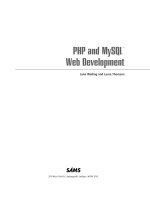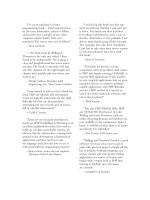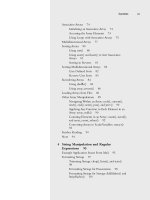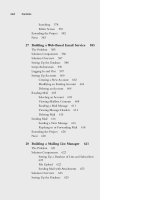PHP and MySQL Web Development - P79 pptx
Bạn đang xem bản rút gọn của tài liệu. Xem và tải ngay bản đầy đủ của tài liệu tại đây (112.65 KB, 5 trang )
362
Chapter 17 Using Network and Protocol Functions
Listing 17.2 directory_submit.html—HTML for the Submission Form
<head>
<title>Submit your site</title>
</head>
<body>
<h1>Submit site</h1>
<form method="post" action="directory_submit.php">
URL: <input type="text" name="url" size="30" value="http://"><br />
Email contact: <input type="text" name="email" size="23"><br />
<input type="submit" name="Submit site">
</form>
</body>
</html>
This is a very simple form—the rendered version, with some sample data entered, is
shown in Figure 17.2.
Figure 17.2 Directory submissions typically require your URL and some
contact details so directory administrators can notify you when
your site is added to the directory.
When the submit button is pressed, we want to check, first, that the URL is hosted on a
real machine, and, second, that the host part of the email address is also on a real
machine.We have written a script to check these things, and the output is shown in
Figure 17.3.
The script that performs these checks uses two functions from the PHP network
functions suite—gethostbyname() and getmxrr().The full script is shown in
Listing 17.3.
22 525x ch17 1/24/03 3:40 PM Page 362
363
Using Network Lookup Functions
Figure 17.3 This version of the script displays the results of checking the
hostnames for the URL and email address—a production version
might not display these results, but it is interesting to see the
information returned from our checks.
Listing 17.3 directory_submit.php—Script to Verify URL and Email Address
<html>
<head>
<title>Site submission results</title>
</head>
<body>
<h1>Site submission results</h1>
<?php
// Extract form fields
$url = $HTTP_POST_VARS['url'];
$email = $HTTP_POST_VARS['email'];
// Check the URL
$url = parse_url($url);
$host = $url['host'];
if(!($ip = gethostbyname($host)))
{
echo 'Host for URL does not have valid IP';
exit;
}
echo "Host is at IP $ip <br />";
// Check the email address
$email = explode('@', $email);
22 525x ch17 1/24/03 3:40 PM Page 363
364
Chapter 17 Using Network and Protocol Functions
$emailhost = $email[1];
// note that the getmxrr() function is *not implemented* in
// Windows versions of PHP
if (!getmxrr($emailhost, $mxhostsarr))
{
echo 'Email address is not at valid host';
exit;
}
echo 'Email is delivered via: ';
foreach ($mxhostsarr as $mx)
echo "$mx ";
// If reached here, all ok
echo '<br />All submitted details are ok.<br />';
echo 'Thank you for submitting your site.<br />'
.'It will be visited by one of our staff members soon.'
// In real case, add to db of waiting sites
?>
</body>
</html>
Let’s go through the interesting parts of this script.
First, we take the URL and apply the parse_url() function to it.This function
returns an associative array of the different parts of a URL.The available pieces of infor-
mation are the scheme, user, pass, host, port, path, query, and fragment.Typically,
you aren’t going to need all of these, but here’s an example of how they make up a
URL.
Given a URL such as
http://nobody::80/script.php?variable=value#anchor
the values of each of the parts of the array would be
n
scheme: http://
n
user: nobody
n
pass: secret
n
host: bigcompany.com
n
port: 80
n
path: script.php
n
query: variable=value
n
fragment: anchor
Listing 17.3 Continued
22 525x ch17 1/24/03 3:40 PM Page 364
365
Using FTP
In our script, we only want the host information, so we pull it out of the array as fol-
lows:
$url = parse_url($url);
$host = $url['host'];
After we’ve done this, we can get the IP address of that host, if it is in the DNS.We can
do this using the gethostbyname() function, which will return the IP if there is one, or
false if not:
$ip = gethostbyname($host);
You can also go the other way using the gethostbyaddr() function, which takes an IP
as parameter and returns the hostname. If you call these functions in succession, you
might well end up with a different hostname from the one you began with.This can
mean that a site is using a virtual hosting service.
If the URL is valid, we then go on to check the email address. First, we split it into
username and hostname with a call to explode():
$email = explode('@', $email);
$emailhost = $email[1];
When we have the host part of the address, we can check to see if there is a place for
that mail to go using the getmxrr() function:
getmxrr($emailhost, $mxhostsarr);
This function returns the set of MX (Mail Exchange) records for an address in the array
you supply at $mxhostarr.
An MX record is stored at the DNS and is looked up like a hostname.The machine
listed in the MX record isn’t necessarily the machine where the email will eventually
end up. Instead it’s a machine that knows where to route that email. (There can be more
than one, hence this function returns an array rather than a hostname string.) If we don’t
have an MX record in the DNS, there’s nowhere for the mail to go.
Note that the getmxrr() function is not implemented in Windows versions of PHP.
If all these checks are okay, we can put this form data in a database for later review by
a staff member.
In addition to the functions we’ve just used, you can use the more generic function
checkdnsrr(), which takes a hostname and returns true if there is any record of it in
the DNS.
Using FTP
File Transfer Protocol, or FTP, is used to transfer files between hosts on a network. Using
PHP, you can use fopen() and the various file functions with FTP as you can with
HTTP connections, to connect to and transfer files to and from an FTP server.
However, there is also a set of FTP-specific functions that comes with the standard PHP
install.
22 525x ch17 1/24/03 3:40 PM Page 365
366
Chapter 17 Using Network and Protocol Functions
These functions are not built in to the standard install by default. In order to use
them under UNIX, you will need to run the PHP configure program with the
enable-ftp option and then rerun make.
If you are using the standard Windows install, FTP functions are enabled auto-
matically.
(For more details on configuring PHP, see Appendix A,“Installing PHP 4 and
MySQL.”)
Using FTP to Back Up or Mirror a File
The FTP functions are useful for moving and copying files from and to other hosts. One
common use you might make of this is to back up your Web site or mirror files at
another location.We will look at a simple example using the FTP functions to mirror a
file.This script is shown in Listing 17.4.
Listing 17.4 ftpmirror.php—Script to Download New Versions of a File from an FTP
Server
<html>
<head>
<title>Mirror update</title>
</head>
<body>
<h1>Mirror update</h1>
<?php
// set up variables - change these to suit application
$host = 'ftp.cs.rmit.edu.au';
$user = 'anonymous';
$password = '';
$remotefile = '/pub/tsg/teraterm/ttssh14.zip';
$localfile = '/tmp/writable/ttssh14.zip';
// connect to host
$conn = ftp_connect("$host");
if (!$conn)
{
echo 'Error: Could not connect to ftp server<br />';
exit;
}
echo "Connected to $host.<br />";
// log in to host
@ $result = ftp_login($conn, $user, $pass);
if (!$result)
{
echo "Error: Could not log on as $user<br />";
22 525x ch17 1/24/03 3:40 PM Page 366









